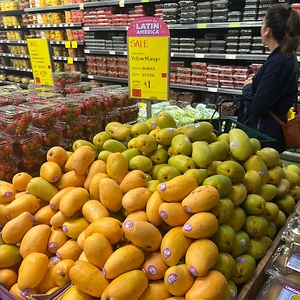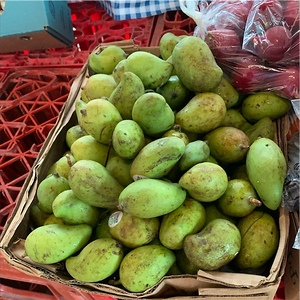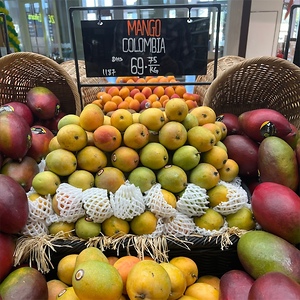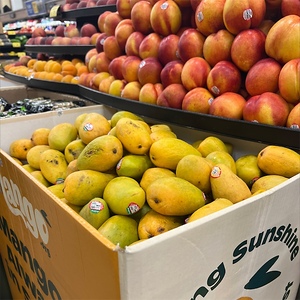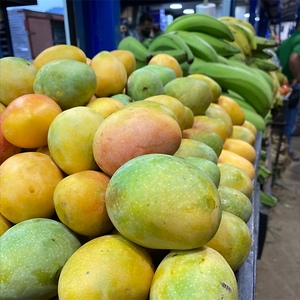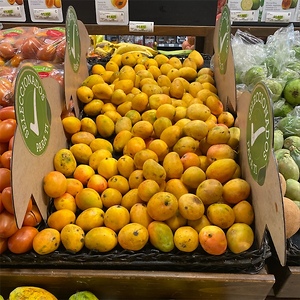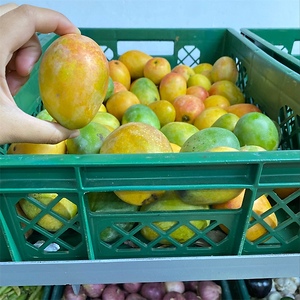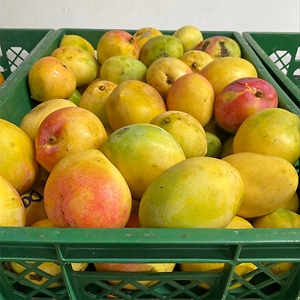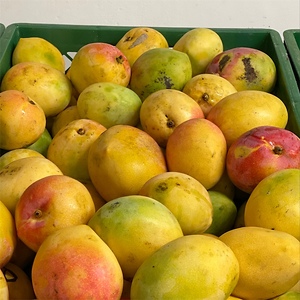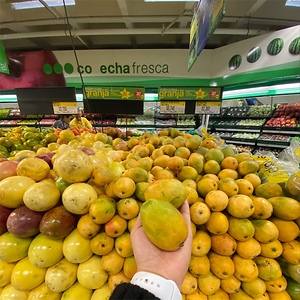

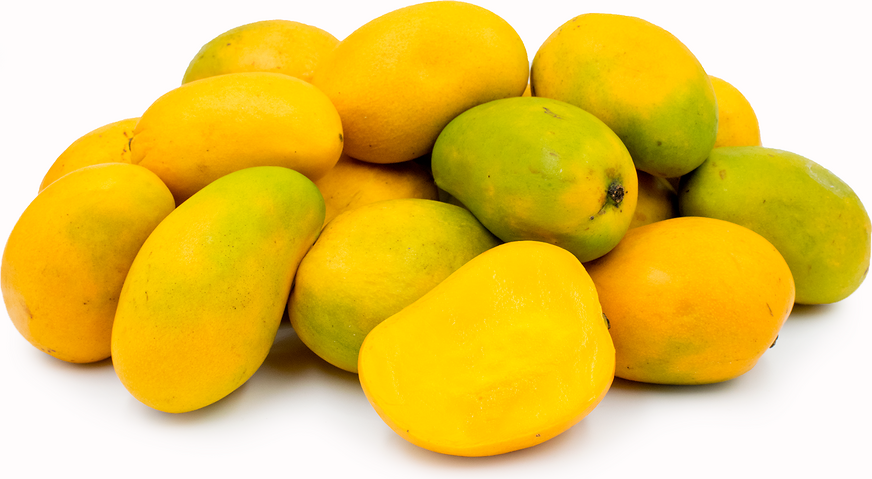
Baby Ataulfo Mangoes
Estimated Inventory, 10 lbs : 0
Description/Taste
Baby Ataulfo mangoes are small, bean-shaped fruits that grow on trees. These mini versions of the Ataulfo mango measure around 7.5 to 10 centimeters in length and about 5 centimeters across. Their skin is a vibrant yellow with touches of light green, and it has a soft, smooth texture that gets squishy when ripe. Inside, the flesh of a Baby Ataulfo mango is creamy and just as bright yellow as the outside. Its non-fibrous flesh is juicy and moist, featuring a relatively small pit that allows for a generous amount of fruit to be consumed. The aroma of these mangoes is sweetly tropical. As they ripen, their scent deepens, blending notes of peach, vanilla, and a hint of citrus zest. Baby Ataulfo mangoes boast an intensely sweet and rich flavor, infused with hints of peach, lemon, honey, and tropical fruits.
Seasons/Availability
Baby Ataulfo mangoes are harvested during from spring to early summer.
Current Facts
The botanical name for Baby Ataulfo mangoes, like all mango varieties, is Mangifera indica, and they are part of the Anacardiaceae family, which also includes species like cashews and pistachios. Originating from Chiapas, Mexico, Ataulfo mangoes emerged from cross-pollination between Spanish varieties and Manila mangoes from the Philippines. Often marketed as champagne mangoes or honey mangos, they underwent a rebranding by the USDA's National Mango Board in 2017 to "honey mangos" due to the difficulty in pronouncing 'Ataulfo.' This renaming received mixed reactions because many believe it dilutes the mango's Mexican heritage, reducing geographic recognition and cultural connection in the U.S. market. Climate change, marked by increased temperatures and unseasonal rainfall, has adversely affected the quality and yield of crops. Despite the significant water required for cultivation, growing mangoes, particularly in Chiapas, is considered beneficial against climate change on various scales, as these mangoes can absorb seven times more carbon dioxide than they emit.
Nutritional Value
Baby Ataulfo mangoes are high in vitamin C, providing up to 67% of your daily needs. They are rich in vitamins B9, B6, A, and K, which can help support brain health, cell growth, bone strength, and infection defense. These mangoes are a good source of minerals like copper, potassium, manganese, and magnesium, all essential for nerve function, healthy blood, and immune support. Baby Ataulfo mangoes contain mangiferin, a powerful antioxidant that can protect your heart by preventing oxidative damage and may help lower cholesterol. Baby Ataulfo mangoes help aid digestion thanks to amylases, enzymes that break down complex carbs into sugars. Since mangoes are related to poison ivy, some people might react to the skin and flesh of unripe, green mangoes, though this is usually not a problem with ripe fruit.
Applications
Baby Ataulfo mangoes can be enjoyed cooked, dried, or most commonly, raw. Their small size means less prep time and chopping for recipes. You can savor these mangoes as a quick snack, sprinkled with chili spices, sliced into salads, or mixed with yogurt and cereal. Baby Ataulfo mangoes’ creamy flavor makes them good in sorbets, mousses, smoothies, and lassis, and they make a good topping for desserts like cakes and tarts. For a zesty touch, chop them into a salsa with onions, cilantro, jalapeños, and lime juice. Cooking options include grilling them lightly with oil, simmering them with sugar and spices to create chutneys, adding them to stir-fries, or pureeing them into sauces. Baby Ataulfo mangoes pair well with oranges, lemons, limes, berries, avocados, cucumbers, onions, bell peppers, seafood, chicken, pork, mint, cayenne pepper, ginger, coconut milk, almonds, and cashews. To ripen, leave Baby Ataulfo mangoes at room temperature, especially if there's any green on the skin. The skin may wrinkle as they reach peak ripeness. Once ripe, they can be refrigerated for up to a week.
Ethnic/Cultural Info
The word "mango" originates from "mânkây," a Dravidian or ancient South Asian term, where "mân" refers to the mango tree and "kây" means fruit. Mangoes are a fundamental part of Mexico's culinary landscape, with fruit vendors on nearly every city corner, often serving fresh mango paired with chamoy sauce. As the world’s largest exporter of mangoes, Mexico shipped 331,148 million tons of the fruit in 2015, primarily serving the American market due to its geographical proximity. Other major mango exporters include India, China, and Thailand.The Ataulfo mango, discovered between the 1940s and 1960s by Ataulfo Morales Gordillo and agronomist Hector Cano Flores, originated on a property acquired by Morales in Chiapas, Mexico. Today, this variety is also cultivated in regions such as Oaxaca, Nayarit, Sinaloa, and Michoacán. The popularity of varieties like the Baby Ataulfo in the United States has surged partly because Americans visit Mexico more than any other country. However, this demand has placed significant pressure on small Mexican mango farms, as American buyers often require large quantities of mangoes, sometimes necessitating farms to produce up to 500,000 square feet of yield, challenging the viability of smaller operations.
Geography/History
Baby Ataulfo mangoes originate from southern Mexico and flourish in tropical and subtropical climates. These conditions provide the warm temperatures and abundant sunlight necessary for their optimal growth. Predominantly cultivated on commercial farms, Baby Ataulfo mangoes are not typically found growing wild, although they can be grown in home gardens in suitable climates. Mangoes spread globally in the 1700s when Portuguese explorers introduced them to South America, leading to their cultivation in southern Mexico by the 19th century. Over time, new varieties such as Ataulfo mangoes were developed, eventually giving rise to the smaller Baby Ataulfo mangoes. The globalization of trade has greatly influenced the mango industry, creating a diverse market for mangos and other exotic fruits in America. Baby Ataulfo mangoes may be available in grocery stores and markets that specialize in tropical fruits, particularly in areas with significant Latin American populations. They may also be found in mainstream supermarkets during their peak season and can also be grown in gardens within their native region.
Recipe Ideas
Recipes that include Baby Ataulfo Mangoes. One
Podcasts



